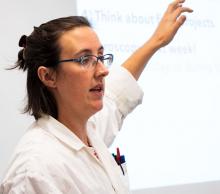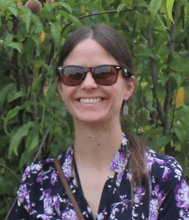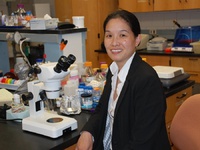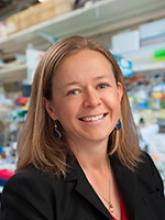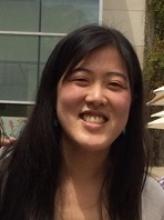Genetics
The study of heredity and the variation of inherited characteristics.
Members of the Genetics Society of America have worked with CourseSource to create a Learning Framework for the Genetics course. The table below lists the learning goals and objectives that the Society agrees any undergraduate biological sciences major should know about Genetics by the time they graduate.
The following people worked to develop this society-approved Genetics Learning Framework:
Ken Burtis (University of California, Davis), Scott Hawley (Stowers Institute), and Michelle Smith (Cornell University).
Download the Genetics Learning Framework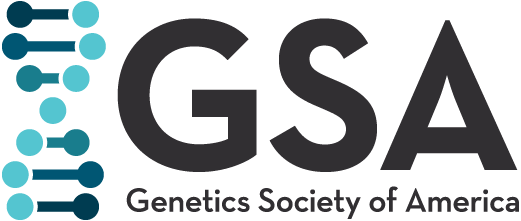
Genetics Society of America
The Genetics Society of America (GSA), founded in 1931, is the professional membership organization for scientific researchers and educators in the field of genetics. Our members work to advance knowledge in the basic mechanisms of inheritance, from the molecular to the population level.
Course Editor(s):
Genetics Learning Framework
Society Learning Goals
Articles
Nature of Genetic Material
How is DNA organized?
Sample Learning Objectives- Explain the meaning of ploidy (haploid, diploid, aneuploid etc.) and how it relates to the number of homologues of each chromosome.
- Describe how the positions of individual genes on a given chromosome are related to their positions on the homolog of that chromosome.
- Differentiate between a gene and an allele, including the recognition that genes may have many alleles.
- Explain the functional significance of packaging DNA into chromosomes and the lack of correlation between chromosome size and genetic information content.
- Describe the types of DNA regions that do not encode proteins: the general organization, possible function, and frequency of genes and non-gene DNA sequences in a typical eukaryotic genome.
- Explain what is meant by single-nucleotide polymorphism (SNP) and short tandem repeat (STR), and explain how SNPs and STRs can be used as genetic markers even if they do not cause phenotypic changes.
- Discuss how DNA is packaged in the chromosomes in terms of histones, nucleosomes, and chromatin.
- Student-Generated Analogies for Learning about Information Flow
- Fragile States: A Case Study Exploring Genetics, Molecular Biology, and Biochemistry Through the Lens of Fragile X Syndrome
- How to Find a Gene: Retrieving Information From Gene Databases
- An undergraduate bioinformatics curriculum that teaches eukaryotic gene structure
- CRISPR/Cas9 in yeast: a multi-week laboratory exercise for undergraduate students
- Using computational molecular modeling software to demonstrate how DNA mutations cause phenotypes
- The Case of the Missing Strawberries: RFLP analysis
- Homologous chromosomes? Exploring human sex chromosomes, sex determination and sex reversal using bioinformatics approaches
What are the molecular components and mechanisms necessary to preserve and duplicate an organism’s genome?
Sample Learning Objectives- Draw a simple line diagram showing a segment of DNA from a gene and its RNA transcript, indicating which DNA strand is the template, the direction of transcription and the polarities of all DNA and RNA strands.
- Describe the process of mitosis, transcription, and translation. How are mistakes in these processes identified and corrected?
- Student-Generated Analogies for Learning about Information Flow
- How to Find a Gene: Retrieving Information From Gene Databases
- Meiosis Remodeled: Inclusion of New Parts to Poppit Bead Models Enhances Understanding of Meiosis
- Teaching the Central Dogma Using a Case Study of Genetic Variation in Cystic Fibrosis
- An undergraduate bioinformatics curriculum that teaches eukaryotic gene structure
- Integrating Manipulatives and Animations to Visualize Holliday Junctions
- You and Your Oral Microflora: Introducing non-biology majors to their “forgotten organ”
- Sex-specific differences in Meiosis: Real-world applications
- Why Meiosis Matters: The case of the fatherless snake
Transmission - Patterns of Inheritance
How can one deduce information about genes, alleles, and gene functions from analysis of genetic crosses and patterns of inheritance?
Sample Learning Objectives- Draw a pedigree based on information in a story problem.
- Using pedigrees, distinguish between dominant, recessive, autosomal, X-linked, and cytoplasmic modes of inheritance.
- Predict the transmission of phenotypes associated with maternal effect genes.
- Explain why the terms “dominant” and “recessive” are context dependent and may differ at the cellular level or at the level of a pedigree.
- Calculate the probability that an individual in a pedigree has a particular genotype (using Bayesian inference if appropriate for course).
- Design genetic crosses to provide information about genes, alleles, and gene functions.
- Interpret the results of experiments comparing the phenotypes that result from single mutations in two different genes with the phenotype of the double mutant, contrasting epistatic and additive interactions.
- Explain how continuous traits are the result of many different gene combinations that can each contribute a varying amount to a phenotype.
- Evaluate how genes and the environment can interact to produce a phenotype.
- Where Does Elsie's Hair Color Come From? A "De-Simplified" Pedigree Lesson
- Fragile States: A Case Study Exploring Genetics, Molecular Biology, and Biochemistry Through the Lens of Fragile X Syndrome
- Engaging Students in Pharmacogenetics: Patient Case Studies Using the PharmGKB Website
- Honoring the Complexity of Genetics: Exploring the Role of Genes and the Environment Using Real World Examples
- A Rapid Genetic Screen Using Wisconsin Fast Plants®: A Hands-On Approach to Inheritance of de novo Mutations
- Learning Quantitative Genetics: Investigation of Genetic Control for Cold Stress Response in Plants
- Mapping a Mutation to its Gene: The "Fly Lab" as a Modern Research Experience
- Interactive Video Vignettes (IVVs) to Help Students Learn Genetics Concepts
- Fruit Fly Genetics in a Day: A Guided Exploration to Help Many Large Sections of Beginning Students Uncover the Secrets of Sex-linked Inheritance
- Predicting and classifying effects of insertion and deletion mutations on protein coding regions
- Teaching Genetic Linkage and Recombination through Mapping with Molecular Markers
- Why do Some People Inherit a Predisposition to Cancer? A small group activity on cancer genetics
- Homologous chromosomes? Exploring human sex chromosomes, sex determination and sex reversal using bioinformatics approaches
- Why Meiosis Matters: The case of the fatherless snake
How does the phenomenon of linkage affect the assortment of alleles during meiosis?
Sample Learning Objectives- Diagram the process of homologous recombination during meiosis and explain how it can lead to new combinations of linked alleles.
- Explain the role of homologous recombination in ensuring proper segregation of homologs in meiosis I
- Explain how a specific combination of linked alleles (haplotype) can persist through many generations (linkage disequilibrium).
- Calculate gene linkage and genetic map distances and interference from the frequencies of progeny with recombinant phenotypes from genetic crosses.
- Explain how genetic distance is different from physical distance.
- Calculate the probability of a particular gamete being produced from an individual, provided map distance.
- Use statistical analysis to determine how well data from a genetic cross or human pedigree analysis fits theoretical predictions including an explanation of the appropriate statistical test.
- Explain the meaning of a LOD score.
What are the mechanisms by which an organism’s genome is passed on to the next generation?
Sample Learning Objectives- Distinguish between somatic and germline cells; listing similarities and differences.
- Compare and explain the inheritance of germline and somatic mutations.
- Describe, using diagrams, the sequence of events involving DNA in meiosis from chromosome duplication through chromosome segregation. Explain how meiosis is different from mitosis.
- Describe the difference between meiosis in mammalian males and females.
- Distinguish between sister chromatids and homologous chromosomes.
- Explain how independent assortment of alleles during meiosis can lead to new combinations of alleles of unlinked genes.
- Discuss how errors in chromosome number can arise during meiosis, and why such alterations can be detrimental
- Explain how abnormalities in gene dosage can affect phenotype.
- Calculate the probability of a particular gamete being produced from an individual, assuming independent segregation.
- Calculate the probability of a particular genotype, given independent segregation and random union of gametes between two individuals.
- Contrast the mechanisms of inheritance of nuclear and organellar genetic information
- The Science and Ethics of Gene Drives: An Active Learning Lesson in Genetics
- A Rapid Genetic Screen Using Wisconsin Fast Plants®: A Hands-On Approach to Inheritance of de novo Mutations
- Mapping a Mutation to its Gene: The "Fly Lab" as a Modern Research Experience
- Fruit Fly Genetics in a Day: A Guided Exploration to Help Many Large Sections of Beginning Students Uncover the Secrets of Sex-linked Inheritance
- Meiosis: A Play in Three Acts, Starring DNA Sequence
- Why do Some People Inherit a Predisposition to Cancer? A small group activity on cancer genetics
- Sex-specific differences in Meiosis: Real-world applications
- Homologous chromosomes? Exploring human sex chromosomes, sex determination and sex reversal using bioinformatics approaches
- Why Meiosis Matters: The case of the fatherless snake
Molecular biology of gene function
How is genetic information expressed so it affects an organism's structure and function?
Sample Learning Objectives- Describe how expansion or retraction of triplet repeats can alter gene function and create a phenotype.
- Explain how the genetic code relates transcription to translation
- Discuss how various factors might influence the relationship between genotype and phenotype (e.g. incomplete penetrance, variable expressivity, and sex-limited phenotype).
- Explain how abnormalities in gene dosage can affect phenotype.
- The Science and Ethics of Gene Drives: An Active Learning Lesson in Genetics
- The Great Petunia Carnage of 2017: A Clicker Case Study Using Petunias to Describe the Effect of Genetic Modification on the Biochemistry of Flower Color and Phenotype in Plants
- Student-Generated Analogies for Learning about Information Flow
- Where Does Elsie's Hair Color Come From? A "De-Simplified" Pedigree Lesson
- Fragile States: A Case Study Exploring Genetics, Molecular Biology, and Biochemistry Through the Lens of Fragile X Syndrome
- Garden Variety Mutations: Using Primary Data to Understand the Central Dogma in Large-Lecture Introductory Biology
- A Muscular Dystrophy Case Study Illustrating the Phenotypic Effects of Mutation
- Application of a Bacterial Experimental Evolution System to Visualize and Teach Evolution in Action: A Course-Based Undergraduate Research Experience
- Teaching the Central Dogma Using a Case Study of Genetic Variation in Cystic Fibrosis
- Single Cell Insights Into Cancer Transcriptomes: A Five-Part Single-Cell RNAseq Case Study Lesson
- Mapping a Mutation to its Gene: The "Fly Lab" as a Modern Research Experience
- Linking Genotype to Phenotype: The Effect of a Mutation in Gibberellic Acid Production on Plant Germination
- A clicker-based case study that untangles student thinking about the processes in the central dogma
- Using Synthetic Biology and pClone Red for Authentic Research on Promoter Function: Genetics (analyzing mutant promoters)
- Using Synthetic Biology and pClone Red for Authentic Research on Promoter Function: Introductory Biology (identifying new promoters)
- You and Your Oral Microflora: Introducing non-biology majors to their “forgotten organ”
Gene Expression and Regulation
How can gene activity be altered in the absence of DNA changes?
Sample Learning Objectives- Discuss the roles of types of RNA other than mRNA in expressing genetic information.
- Contrast the packaging of DNA into euchromatin versus heterochromatin in the context of histone modification, and DNA modification (where applicable)
- Defend how most cells can have the same genetic content and yet have different functions in the body.
- Discuss the potential roles of DNA modification, histone modification, and non-coding RNA in epigenetic inheritance, both somatic and germline
- Discuss environmental impacts on epigenetic systems
- The Great Petunia Carnage of 2017: A Clicker Case Study Using Petunias to Describe the Effect of Genetic Modification on the Biochemistry of Flower Color and Phenotype in Plants
- Splicing it Together: Using Primary Data to Explore RNA Splicing and Gene Expression in Large-Lecture Introductory Biology
- Targeting Misconceptions in the Central Dogma by Examining Viral Infection
How do genes and genomes control changes in an organism's structure and function throughout its life cycle?
Sample Learning Objectives- Describe how differential histone modification modulates gene activity and is utilized in developmental progression .
- Use a model systems to describe investigations of evo-devo.
- Describe genetic cascades; use the sex-determination cascade to explain how differential gene expression can result in the development of different sexes.
- Explain how polarity is established in a developing embryo using gene expression gradients.
Genetic variation
How do different types of mutations affect genes and the corresponding mRNAs and proteins?
Sample Learning Objectives- Describe how duplications, deletions, inversions, and translocations can affect gene function, gene expression, and genetic recombination. Describe the same for transposable elements.
- Describe how mutations arise and how environmental factors can increase mutation rate.
- Cite examples of mutations that can be beneficial to organisms.
- Interpret results from experiments to distinguish between different types of DNA rearrangements.
- Distinguish between loss of function and gain of function mutations and their potential phenotypic consequences.
- Predict the most likely effects on protein structure and function of null, reduction-of-function, overexpression, dominant-negative and gain-of-function mutations.
- Compare the role of both loss and gain of function mutations in the origin of tumors
- The Great Petunia Carnage of 2017: A Clicker Case Study Using Petunias to Describe the Effect of Genetic Modification on the Biochemistry of Flower Color and Phenotype in Plants
- Using Raw Sequence Data to Analyze Tumor Suppressor Mutations
- Student-Generated Analogies for Learning about Information Flow
- Garden Variety Mutations: Using Primary Data to Understand the Central Dogma in Large-Lecture Introductory Biology
- A Muscular Dystrophy Case Study Illustrating the Phenotypic Effects of Mutation
- Application of a Bacterial Experimental Evolution System to Visualize and Teach Evolution in Action: A Course-Based Undergraduate Research Experience
- Metastatic Mastery: A Case and Game-Based Approach to Learning About Cancer Mechanisms
- Escape Zoom!: Reviewing Introductory Evolution Content Using an Escape Room Format
- Teaching the Central Dogma Using a Case Study of Genetic Variation in Cystic Fibrosis
- Follow the Sulfur: Using Yeast Mutants to Study a Metabolic Pathway
- Mapping a Mutation to its Gene: The "Fly Lab" as a Modern Research Experience
- A CRISPR/Cas Guide RNA Design In Silico Activity
- My Dog IS My Homework: Exploring Canine Genetics to Understand Genotype-Phenotype Relationships
- Discovering Prokaryotic Gene Regulation with Simulations of the trp Operon
- GMC: Genes, Mutations and Cancer - Group Concept Map Development
- Linking Genotype to Phenotype: The Effect of a Mutation in Gibberellic Acid Production on Plant Germination
- A clicker-based case study that untangles student thinking about the processes in the central dogma
- Predicting and classifying effects of insertion and deletion mutations on protein coding regions
- Using computational molecular modeling software to demonstrate how DNA mutations cause phenotypes
- Using Synthetic Biology and pClone Red for Authentic Research on Promoter Function: Genetics (analyzing mutant promoters)
- Using Synthetic Biology and pClone Red for Authentic Research on Promoter Function: Introductory Biology (identifying new promoters)
- Building a Model of Tumorigenesis: A small group activity for a cancer biology/cell biology course
- Exploration of the Human Genome by Investigation of Personalized SNPs
- Homologous chromosomes? Exploring human sex chromosomes, sex determination and sex reversal using bioinformatics approaches
Evolution and Population genetics
What are the processes that can affect the frequency of genotypes and phenotypes in a population over time?
Sample Learning Objectives- Describe the mechanisms by which variation arises and is fixed (or lost) in a population over time.
- Calculate allele frequencies based on phenotypic or genotypic data for a population, and be able to explain the assumptions that make such a calculation possible.
- Model how random mating yields predicted genotype frequencies in Hardy-Weinberg Equilibrium (HWE), and how non-random mating affects allele and genotype frequencies.
- Test whether HWE has been reached in a population.
- Explain how inbreeding increases the number of homozygotes (and possibly disease) in comparison to HWE.
- Explain how natural selection and genetic drift can affect the elimination, maintenance or increase in frequency of various types of alleles (e.g. dominant, recessive, deleterious, beneficial) in a population.
- Interpret experiments to determine the relative influences of genes and the environment on a given phenotype.
- Describe how variation can be measured, and what can be done to distinguish genetic and environmental sources of variation.
- Interpret bioinformatics data to compare homologous genes in different species and infer relative degrees of evolutionary relatedness.
- Use comparative data from multiple species to identify which regions of a protein, pathway, regulatory system etc. are critical for function.
- The Science and Ethics of Gene Drives: An Active Learning Lesson in Genetics
- Honoring the Complexity of Genetics: Exploring the Role of Genes and the Environment Using Real World Examples
- Escape Zoom!: Reviewing Introductory Evolution Content Using an Escape Room Format
- A 360˚ View of COVID-19
- A Quick and Simple Natural Selection Role Play
- Why do Some People Inherit a Predisposition to Cancer? A small group activity on cancer genetics
- Sex-specific differences in Meiosis: Real-world applications
Genetics of model organisms
How do the results of molecular genetic studies in model organisms help us understand aspects of human genetics and genetic diseases?
Sample Learning Objectives- Justify why information on functions of human genes can often be acquired through studies of simple model organisms such as yeast, nematode worms, and fruit flies.
- Compare the benefits and limitations of using model organisms to study human genes and human genetic diseases. Identify specific cases where insights from model organisms have provided crucial insights into human disease.
- Defend the assertion that genetic testing will play a central role in the diagnosis and treatment of cancer in the future.
- Understanding the Importance of Microtubules in Normal Cell Division: Chemotherapy Connection
- Application of a Bacterial Experimental Evolution System to Visualize and Teach Evolution in Action: A Course-Based Undergraduate Research Experience
- A CRISPR/Cas Guide RNA Design In Silico Activity
- Using Synthetic Biology and pClone Red for Authentic Research on Promoter Function: Genetics (analyzing mutant promoters)
- Using Synthetic Biology and pClone Red for Authentic Research on Promoter Function: Introductory Biology (identifying new promoters)
- Exploration of the Human Genome by Investigation of Personalized SNPs
Methods & Tools in Genetics
What experimental methods are commonly used to analyze gene structure and gene expression?
Sample Learning Objectives- Explain reverse genetics and compare methods for generating specific mutations in the genome vs. generating phenocopies using techniques such as RNAi or morpholinos.
- Explain the method of SNP/STR mapping and interpret SNP/STR mapping data to pinpoint the chromosomal location of a human disease gene.
- Interpret complementation tests, including an assessment of the molecular interactions that might yield the results observed.
- Using Raw Sequence Data to Analyze Tumor Suppressor Mutations
- Understanding the Importance of Microtubules in Normal Cell Division: Chemotherapy Connection
- How to Find a Gene: Retrieving Information From Gene Databases
- Learning Quantitative Genetics: Investigation of Genetic Control for Cold Stress Response in Plants
- A 360˚ View of COVID-19
- Single Cell Insights Into Cancer Transcriptomes: A Five-Part Single-Cell RNAseq Case Study Lesson
- An undergraduate bioinformatics curriculum that teaches eukaryotic gene structure
- Mapping a Mutation to its Gene: The "Fly Lab" as a Modern Research Experience
- Make It Stick: Teaching Gene Targeting with Ribbons and Fasteners
- A Close-Up Look at PCR
- An Introduction to Eukaryotic Genome Analysis in Non-model Species for Undergraduates: A tutorial from the Genome Consortium for Active Teaching
- Predicting and classifying effects of insertion and deletion mutations on protein coding regions
- Using computational molecular modeling software to demonstrate how DNA mutations cause phenotypes
- Using Synthetic Biology and pClone Red for Authentic Research on Promoter Function: Genetics (analyzing mutant promoters)
- Teaching Genetic Linkage and Recombination through Mapping with Molecular Markers
- Using Synthetic Biology and pClone Red for Authentic Research on Promoter Function: Introductory Biology (identifying new promoters)
- A Hands-on Introduction to Hidden Markov Models
- A Kinesthetic Modeling Activity to Teach PCR Fundamentals
- Using Undergraduate Molecular Biology Labs to Discover Targets of miRNAs in Humans
- You and Your Oral Microflora: Introducing non-biology majors to their “forgotten organ”
- The Case of the Missing Strawberries: RFLP analysis
Genetics & Ethics
How does genetics impact society and society impact genetics?
Sample Learning Objectives- Compare the benefits and risks associated with the acquisition, ownership and storage of personal genetic and genomic information.
- Defend the assertion that genetic testing will play a central role in the diagnosis and treatment of cancer in the future.
- Contrast past and present views about how genetic information should be used by society, employers, and the government in support of public policies.
- Write about how obtaining personal genetic information could lead to negative consequences affecting others.
- Defining Life: Exploring Creativity, Scientific Discovery, and Biology Core Concepts in a Disciplinary First-Year Seminar
- A Muscular Dystrophy Case Study Illustrating the Phenotypic Effects of Mutation
- Casting a Wide Net via Case Studies: Educating across the undergraduate to medical school continuum in the biological sciences
- Exploration of the Human Genome by Investigation of Personalized SNPs
- Homologous chromosomes? Exploring human sex chromosomes, sex determination and sex reversal using bioinformatics approaches

